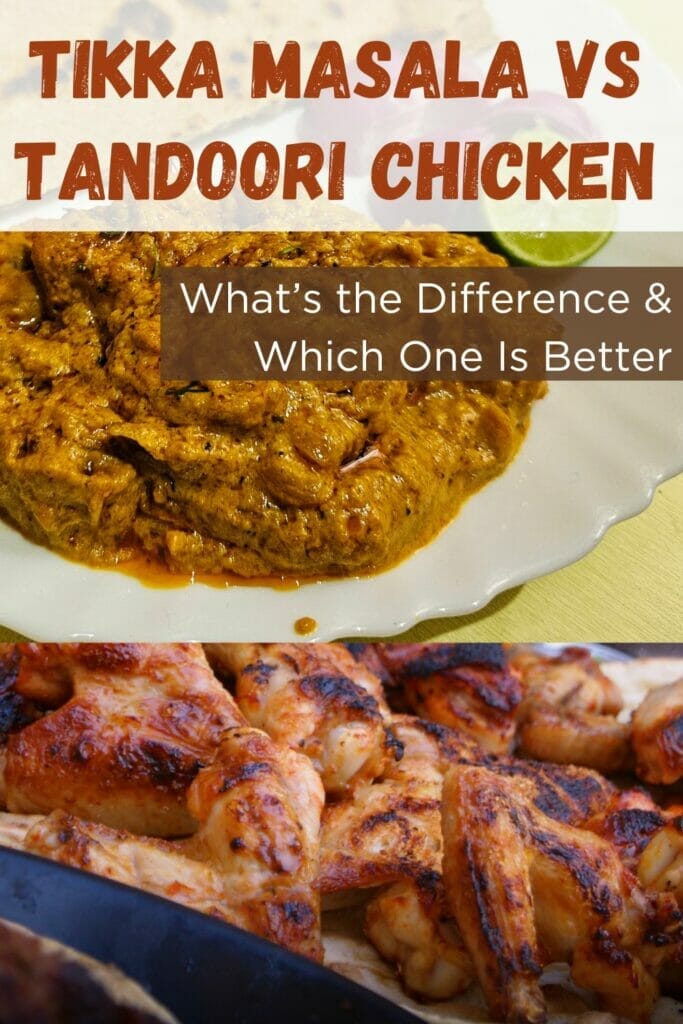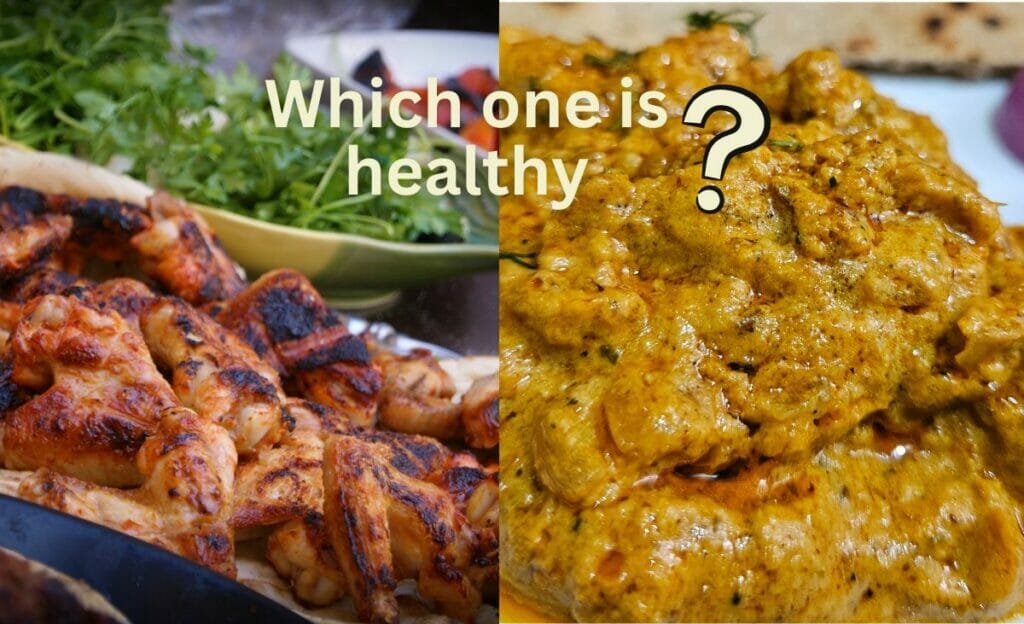If you enjoy Indian food, the two well-known chicken dishes tikka masala and tandoori chicken are probably familiar to you. Both dishes are well-known and frequently ordered in Indian restaurants or prepared at home for a delectable meal.
But if you enjoy Indian cuisine and are having trouble choosing between the two, you’ve come to the right place!
In this post, I’ll compare tikka masala and tandoori chicken and go into their histories, cooking techniques, flavors, and more.
I’ll assist you in selecting the best option for you, whether you want to order takeout or try your hand at making one of these dishes at home.
Tandoori chicken is a dry, spicy dish marinated in yogurt and spices, whereas tikka masala is a creamy, tomato-based dish. Both meals are great and have their own distinct flavors and textures, so try them both to discover which one you like.
Continue reading if you’re still unsure about which food to try. The history of both dishes, the many cooking techniques, the ingredients utilized, and even the nutritional value of each dish will all be covered in this article.
Along with some variations you can try to make the dishes your own, I’ll also go over some suggestions for preparing these dishes at home.
This article will therefore have something for you whether you’re an avid tikka masala or tandoori chicken fan or if you’re absolutely unfamiliar with Indian food.

Difference Between Tikka Masala and Tandoori Chicken (Table)
Here’s a table showing the difference between tikka masala and tandoori chicken.
| Factors | Tikka Masala | Tandoori Chicken |
|---|---|---|
| Origin | Believed to be created in the UK in the 1960s | Originated in Punjab, northern India |
| Texture | Soft and tender due to the creamy tomato-based sauce | Firm and slightly chewy due to marination in yogurt and spices |
| Cooking Method | Cooked on stovetop or in an oven | Traditionally cooked in a tandoor oven |
| Flavor | Creamy, tangy, and slightly spicy | Smoky and flavorful with a blend of spices |
| Presentation | Served in a sauce with rice or bread | Presented as bone-in or boneless pieces, often on skewers |
| Calories | Typically higher due to the creamy sauce | Relatively lower as it is grilled or baked |
| Ingredients | Tomato-based sauce, cream, and spices | Yogurt, spices, and a blend of aromatic spices |
| Nutritional Value | Higher in fat and carbohydrates | Lower in fat and carbohydrates, higher in protein |
Tandoori Chicken vs. Tikka Masala (The Differences)

There are some notable differences between the two well-known Indian meals chicken tikka masala and tandoori chicken.
Color differences:
Tandoori chicken is distinguished by its crimson coloring, which results from the addition of tandoori masala, a blend of paprika, red chili powder, and turmeric to the oven.
The tomato-based sauce used to make chicken tikka masala is often thickened with cream or yogurt, giving it a creamy, orange tint.
Differences in flavor:
Because it is traditionally cooked in a tandoor oven, tandoori chicken has a smokey flavor. Yogurt, ginger, garlic, and a mixture of spices are used in the marinade for tandoori chicken to give it a pleasantly spicy and sour flavor.
The tomato-based sauce used in chicken tikka masala, in contrast, is flavored with a mixture of spices, including coriander, cumin, and garam masala. As a result, it has a creamier and sweeter flavor. The dish gets a slight tanginess and creaminess from the yogurt added to the sauce.
Differences in the chicken used in the recipes:
Both recipes call for boneless chicken pieces, but they are prepared differently.
Tandoori chicken is marinated for many hours or overnight in a mixture of yogurt, spices, and lemon juice before being cooked in a tandoor oven. The marinade imparts flavor and helps to tenderize the chicken.
But to make chicken tikka masala, the chicken is first grilled or baked, and then it is simmered in a tomato-based sauce.
In contrast to tandoori chicken, which is typically served in larger chunks like chicken legs or thighs, chicken tikka masala typically uses cubed chicken.
Difference in texture:
Chicken tikka masala has a softer texture than tandoori chicken, which is harder.
In order to tenderize the chicken and give it a little chewy texture, tandoori chicken is marinated in yogurt and spices.
A creamy tomato-based sauce is used to cook the chicken in chicken tikka masala, which results in more tender flesh and a softer texture.
Difference in cooking time:
Tandoori chicken often requires more time to prepare than chicken tikka masala.
Ideally, you’ll need to marinate the chicken two times to make the perfect tandoori chicken. This whole process takes more time in preparation than the preparation of chicken tikka masala, which you’ll need to marinate only once.
Besides that, the cooking time differs by roughly ten minutes.
Tandoor ovens, which are high-temperature clay ovens, are typically used to prepare tandoori chicken.
Tandoor ovens can be used to cook tandoori chicken for 20 to 30 minutes. On the other hand, cooking chicken tikka masala on a stovetop or in an oven only takes approximately 30 to 40 minutes.
Difference in cooking method:
Chicken tikka masala and tandoori chicken are prepared in various ways. Tandoor ovens, which are clay ovens that are heated with charcoal, are typically used to prepare tandoori chicken.
However, you can also use an oven to make tandoori chicken.
The marinated chicken is being skewered and cooked in the tandoor oven for roughly 20-30 minutes. The chicken comes out of the oven with a crispy surface and a smokey flavor.
On the other hand, chicken tikka masala is typically prepared in an oven or on a stovetop. After marinating, the chicken is cooked on a grill or in an oven. The finished meal is then cooked in a creamy tomato-based sauce.
Difference in serving:
Tandoori chicken is typically offered in Indian restaurants as an appetizer or as a main meal. It is frequently served whole, bone-in chicken thighs or legs or as boneless chicken chunks on a skewer.
Contrarily, chicken tikka masala is typically served as a main dish and is paired with rice, naan bread, or roti.
Difference in origin:
Tandoori chicken and chicken tikka masala have diverse places of origin.
Chicken was historically marinated in yogurt and spices before being cooked in a tandoor oven to create the dish that is claimed to have originated in Punjab, a province of northern India. However, it is thought that chicken tikka masala, which is similar to tandoori chicken but typically smaller in size, was invented in the UK in the 1960s by grilling chicken tikka.
Difference in ingredients:
Different ingredient lists can be found for chicken tikka masala and tandoori chicken.
In order to make tandoori chicken, chicken that is either bone-in or boneless is marinated in yogurt and a blend of spices that includes ginger, garlic, cumin, coriander, and garam masala.
A tandoor oven is used to finish cooking the chicken, giving it a smokey flavor and a crispy exterior.
In contrast, boneless chicken is used to make chicken tikka masala, which is then baked or grilled after being marinated in a mixture of yogurt and spices.
After that, the chicken is cooked in a tomato-based sauce that frequently consists of tomatoes, cream, onions, garlic, ginger, and a mixture of spices like cumin, coriander, and garam masala.
Difference in nutritional value:
Here are the differences between tandoori chicken and chicken tikka masala in terms of their nutritional values.
Calories:
When compared to tandoori chicken, chicken tikka masala often has more calories. A standard serving of tandoori chicken (100g) has about 160–180 calories, while a serving of chicken tikka masala (200g) has about 350–400 calories.
Protein:
Tandoori chicken and chicken tikka masala are both excellent sources of protein. In comparison to tandoori chicken, which has about 18–20g of protein per serving, chicken tikka masala has about 25–30g of protein per dish.
Carbohydrates:
Due to the tomato-based sauce used in the dish, chicken tikka masala has a greater carbohydrate load than tandoori chicken. While a serving of tandoori chicken only has 2-3g of carbohydrates, a serving of chicken tikka masala has about 25-30g.
Fiber:
With less than 1g of fiber per serving, neither tandoori chicken nor chicken tikka masala are notable sources of dietary fiber.
Fat:
Because cream and ghee (clarified butter) are used in the recipe, chicken tikka masala often has more fat than tandoori chicken. While a serving of tandoori chicken only has about 5-8g of fat, a serving of chicken tikka masala has about 15-20g of fat.
Which is healthier chicken tikka masala or tandoori chicken?

Due to its lower calorie, carbohydrate, and fat content, tandoori chicken is generally thought to be healthier than chicken tikka masala.
Tandoori chicken is often marinated in a yogurt and spice mixture before being grilled or baked, producing a dish that is lean and high in protein.
Contrarily, chicken tikka masala is frequently prepared with marinated chicken that is cooked in a creamy tomato-based sauce that may have extra fats and calories.
It’s crucial to remember that the nutritional content of both dishes might change based on the precise recipe and cooking techniques used. The cuisine that is deemed healthier for a particular person may also depend on their specific nutritional needs and preferences.
Which is better chicken tikka masala or tandoori chicken?

Choosing between chicken tikka masala and tandoori chicken is a matter of taste and personal preference.
Tandoori chicken is grilled after being marinated in yogurt and spices, producing a delicious, tender chicken with a crunchy surface. Usually, it comes with a side of rice or veggies.
On the other hand, boneless chicken pieces are used to make chicken tikka masala, which is cooked in a rich tomato-based sauce after being marinated in spices and yogurt. It has a zesty flavor and a creamy texture.
Individual preferences ultimately determine which food is preferred between the two due to their distinct flavors, textures, and preparation techniques.
While some people prefer the creamy and tangy flavor of chicken tikka masala, others prefer the smoky flavor and crispy texture of tandoori chicken. It is so difficult to determine which food is superior because it mostly depends on the tastes and preferences of the individual.
Related articles:
- Tikka Masala vs Butter Chicken: What’s the Difference and Which One Is Better?
- Chicken Tikka Masala vs. Chicken Marsala: Exploring Two Iconic Chicken Delights
- Butter Chicken vs Tandoori Chicken (Exploring the Contrasts)
- Chicken Tikka Masala vs Chicken Vindaloo (Exploring the Differences)
- Chicken Tikka Masala vs Chicken Korma (Exploring Indian Cuisine)
- Chicken Tikka Masala vs Chicken Handi: Exploring the Difference
- Chicken Tikka Masala vs Chicken Saag: A Flavorful Face-Off
- Chicken Tikka Masala vs. Chicken Madras: Decoding the Curry Clash
- Is Chicken Tikka Masala Spicy? Here’s What You Need to Know
- What Does Chicken Tikka Masala Taste Like?
- Chicken Curry Vs Chicken Tikka Masala: A Comparative Analysis
- Tandoori Chicken vs Grilled Chicken: Battle of the BBQ Stars
- Tandoori Chicken vs Chicken 65: Deciphering Indian Delights
- Tandoori Chicken vs Chicken Kebab: A Grilled Face-Off
- Chicken 65 vs Chicken Tikka: Spicy Bites or Smoky Delight?
- Tandoori Chicken vs Roasted Chicken: Exploring Culinary Contrasts
- Chicken Masala vs Chicken Tikka Masala: Spice vs. Creamy Elegance
